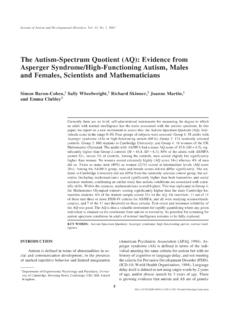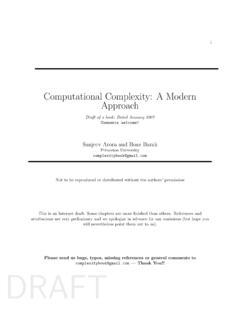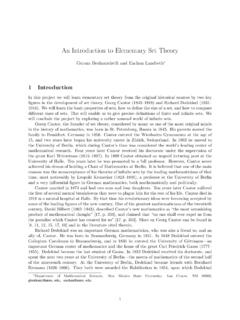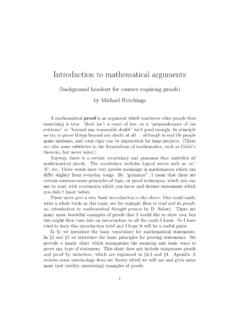Transcription of Principles of Flight: Bernoulli's Principle - NASA
1 National Aeronautics and Space AdministrationGRADESK-4principles of flightBernoulli s PrincipleAeronautics ResearchMission DirectorateMuseumin aBOXM useumin aBOXS eriesMuseumin aBOXM useumin aBOXS eriesSerie of flightMUSEUM IN A BOX bernoulli s PrincipleLesson OverviewIn this lesson, students will learn about forces and motion as they see how the work of Daniel bernoulli and Sir Isaac Newton help explain flight. Students will also learn how lift and gravity, two of the four forces of flight, act on an airplane while it is in the air. Additionally, students will experiment with the bernoulli Principle .
2 Students will relate the bernoulli Principle to lift. Finally, students will relate the bernoulli Principle to lift and apply the first and third laws of Sir Isaac Newton to flight. Objectives Students will:1. Explore the bernoulli Principle , which states that the speed of a fluid (air, in this case) determines the amount of pressure that a fluid can exert. Determine that though two items look identical, they may not have the same Relate the bernoulli Principle to the lift, one of the four forces of flight. 3. Explore, within the context of the bernoulli Principle activities, how Newton s first and third laws of motion contribute to :In the BoxLarge paper grocery bagScissorsTape or glue stickRulerVariety of balloon shapes (optional)2 large balloons2 lengths of string 30cm eachStraight straw (optional)1 large trash bag1 hair dryer or small fan with at least two speeds1 ping-pong ball Provided by UserPaperAssortment of large felt tip markers (washable)GRADESK-4 Time Requirements.
3 3 hours3principles of flightMUSEUM IN A BOXB ackgroundHow is it that today s airplanes, some of which have a maximum take off weight of a million pounds or more, are able to get off the ground in the first place, let alone fly between continents? Surprisingly, with today s technological advances, airplanes use the same Principles of aerodynamics used by the Wright brothers in 1903. In order to gain an understand-ing of flight, it is important to understand the forces of flight (lift, weight, drag, and thrust), the bernoulli Principle , and Newton s first and third laws of motion.
4 Although the activities in this lesson primarily focus on the role the bernoulli Principle plays in the ability of aircraft to achieve lift, the bernoulli Principle is not the only reason for flight. The Forces of FlightAt any given time, there are four forces acting upon an aircraft. These forces are lift, weight (or gravity), drag and thrust. Lift is the key aerodynamic force that keeps objects in the air. It is the force that opposes weight; thus, lift helps to keep an aircraft in the air. Weight is the force that works vertically by pulling all objects, including aircraft, toward the center of the Earth.
5 In order to fly an aircraft, something (lift) needs to press it in the opposite direction of gravity. The weight of an object controls how strong the pressure (lift) will need to be. Lift is that pressure. Drag is a mechanical force generated by the interaction and contract of a solid body, such as an airplane, with a fluid (liquid or gas). Finally, the thrust is the force that is generated by the engines of an aircraft in order for the aircraft to move 1 Four forces of flightNewton s Laws of MotionAnother essential that applies to understanding how airplanes fly are the laws of motion described by Sir Isaac Newton.
6 Newton (1642 -1727) was an English physicist, mathematician, astronomer, alchemist, theologian and natural philosopher. He has long been considered one of the most influential men in human history. In 1687, Newton published the book Philosophiae Naturalis Principia Mathematica , commonly known as the Principia . In Principia , Newton explained the three laws of motion. Newton s first and third laws of motion are especially helpful in explaining the phenomenon of flight. The first law states that an object at rest remains at rest while an object in motion remains in motion, unless acted upon by an external force.
7 Newton s second law states that force is equal to the change in momentum per change in time. For constant mass, force equals mass times acceleration or F=m a. Newton s third law states that for every action, there is an equal and opposite 1 Sir Isaac Newton (age 46) (Painting by Sir Godfrey Kneller - 1689)4principles of flightMUSEUM IN A BOXThe bernoulli PrincipleDaniel bernoulli (1700 1782) was a Dutch-born scientist who studied in Italy and eventually settled in Switzerland. Born into a family of renowned mathematicians , his father, Johann bernoulli , was one of the early developers of calculus and his uncle Jacob bernoulli , was the first to discover the theory of probability.
8 Although brilliant, Johann bernoulli was both ambitious for his son Daniel and jealous of his son s success. Johann insisted that Daniel study business and later medicine, which Daniel did with distinction. It was mathematics, however, that really captured Daniel s interest and imagination. Despite Daniel s best efforts, Johann never acknowledged his son s brilliance and even tried to take credit for some of Daniel s most important Daniel s studies, he moved to Venice where he worked on mathematics and practical medicine. In 1724, he published Mathematical exercises, and in 1725 he designed an hourglass that won him the prize of the Paris Academy, his first of ten.
9 As a result of his growing fame as a mathematician, Daniel was invited to St. Petersburg to continue his research. Although Daniel was not happy in St. Petersburg, it was there that he wrote Hydrodynamica , the work for which he is best known. bernoulli built his work off of that of Newton. In 1738, he published Hydrodynamica , his study in fluid dynamics, or the study of how fluids behave when they are in motion. Air, like water, is a fluid; however, unlike water, which is a liquid, air is a gaseous substance. Air is considered a fluid because it flows and can take on different shapes.
10 bernoulli asserted in Hydrodynamica that as a fluid moves faster, it produces less pressure, and conversely, slower moving fluids produce greater pressure. Img. 2 Daniel bernoulli (Public Domain)hpV1P1A112V2P2A2 Fig. 2 bernoulli fluid experimentWe are able to explain how lift is generated for an airplane by gaining an understanding of the forces at work on an airplane and what Principles guide those forces. First, it takes thrust to get the airplane moving - Newton s first law at work. This law states that an object at rest remains at rest while an object in motion remains in motion, unless acted upon by an external force.
















